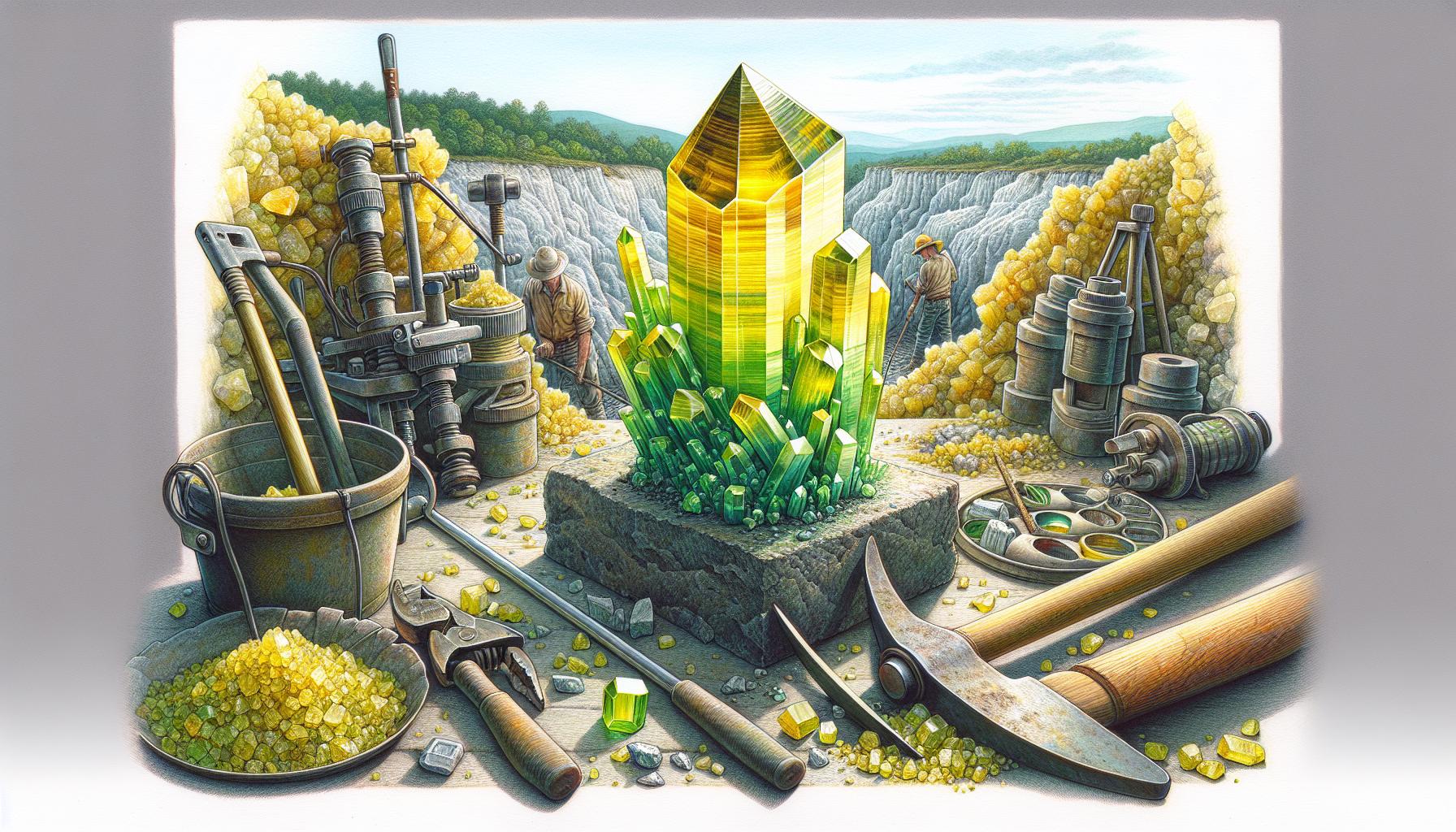Imagine holding a gem that captures the vibrant energy of Brazil’s lush landscapes. Brazilianite, a rare and stunning crystal, does just that. Its striking yellow-green hue not only makes it a visual delight but also a sought-after treasure among collectors and crystal enthusiasts.
You might be wondering what makes Brazilianite so special. Beyond its captivating appearance, this crystal is believed to possess unique metaphysical properties that can enhance creativity and personal growth. Whether you’re a seasoned collector or a curious newcomer, Brazilianite offers a fascinating glimpse into the world of natural gemstones.
Key Takeaways
- Unique Properties: Brazilianite is a rare crystal known for its striking yellow-green hue and its potential to enhance creativity and personal growth through metaphysical properties.
- Origin and Discovery: Discovered in the early 1940s in Minas Gerais, Brazil, Brazilianite derives its name from this country and is notable for forming in prismatic, tabular shapes within phosphate-rich pegmatites.
- Physical Characteristics: With a hardness of 5.5 on the Mohs scale, Brazilianite features perfect cleavage and a vitreous lustre, composed chemically of sodium aluminium phosphate.
- Varied Uses: Besides its aesthetic appeal in jewellery and decorative arts, Brazilianite is valued for its ability to stimulate mental clarity and reduce anxiety, making it popular for both metaphysical and practical applications.
- Mining Techniques: Brazilianite is primarily mined in Brazil using manual and small-scale mechanical methods to preserve the crystal’s quality while adhering to strict environmental regulations.
- Care Instructions: To maintain their beauty, Brazilianite crystals should be cleaned with mild soap and lukewarm water, stored away from direct sunlight, and kept in cushioned environments to avoid damage.
Unveiling the Beauty of Brazilianite Crystal
Brazilianite crystals captivate with their vivid yellow-green colour, resembling Brazil’s lush landscapes. Their distinct vibrancy makes them a prized addition to any gem collection.
Origins and Discovery
First identified in Brazil in the early 1940s, Brazilianite crystals derive their name from their country of origin. Vorder-andalusite miner Henry P. Brown made the initial discovery in the state of Minas Gerais. The presence of these crystals in phosphate-rich pegmatites contributes to their impressive clarity and colour.
Physical and Chemical Properties
Brazilianite crystals typically form in prismatic, tabular shapes with perfect cleavage along one plane. Their hardness measures around 5.5 on the Mohs scale, placing them between fluorite and feldspar in terms of durability. Chemically, Brazilianite is composed of sodium aluminium phosphate, denoted by NaAl3(PO4)2(OH)4, which influences its transparency and colouration. Additionally, the crystal’s vitreous lustre adds to its aesthetic allure, making it a popular choice for jewellery and ornamental pieces.
Brazilianite Crystal Uses and Significance
Brazilianite crystals captivate gem enthusiasts not only for their beauty but also for their diverse uses and significant properties.
Metaphysical Properties
Brazilianite crystals, known for their energetic qualities, enhance mental clarity and creativity. Practitioners believe these crystals stimulate the third eye and solar plexus chakras, promoting intellectual insights and personal power. Individuals using Brazilianite for meditation often experience heightened intuition and spiritual guidance. Several metaphysical stores and online platforms recommend Brazilianite for its calming effects on the mind, helping to reduce anxiety and stress.
Practical Applications
Beyond metaphysical uses, Brazilianite finds practical applications in jewellery and decorative arts. Its vivid yellow-green colour makes it a striking choice for rings, necklaces, and earrings. Jewelers often pair Brazilianite with silver or gold to create elegant, eye-catching pieces. Crystal collectors value Brazilianite for its rarity and aesthetic appeal, displaying it in mineral collections and curio cabinets. Additionally, some artists incorporate Brazilianite into sculptures and bespoke home decor, adding a unique touch to their creations.
Mining and Procurement of Brazilianite

Mining Brazilianite crystals involves specific techniques and targeted locations to preserve their pristine quality.
Major Locations and Techniques
You can find the primary mining sites for Brazilianite in Brazil, particularly in the states of Minas Gerais and Bahia. Miners use pegmatite-rich geological formations to locate these crystals, which lie within phosphate-rich pockets.
Techniques involve manual tools like hammers and chisels to carefully extract Brazilianite crystals without causing damage. In some areas, miners use small-scale mechanical equipment to expedite the process while preserving crystal integrity. They often sort these crystals on-site to separate high-quality specimens from less desirable ones. These meticulous methods ensure that you get Brazilianite in its finest form, ready for further processing and use.
Strict safety and environmental regulations govern mining practices. Sustainable methods and minimal environmental impact are prioritised to ensure the longevity of mining sites and the surrounding ecosystem.
Caring for Your Brazilianite Crystals
Brazilianite crystals, with their vibrant yellow-green hues, require care to maintain their beauty and energy. Follow these guidelines to keep your crystals in pristine condition.
Cleaning and Maintenance
Use lukewarm water and mild soap for cleaning your Brazilianite crystals. Gently scrub the surface with a soft brush, avoiding harsh chemicals that could damage the crystal. Rinse thoroughly with water and dry with a soft, lint-free cloth.
Avoid prolonged exposure to direct sunlight, as it can fade the crystal’s colour over time. For storage, wrap each crystal in a soft cloth or place it in a cushioned box to prevent scratches and other physical damage.
Conclusion
Brazilianite crystals are truly remarkable gems that offer both aesthetic beauty and metaphysical benefits. Their unique yellow-green hue and rarity make them a prized addition to any collection. By understanding their origins and the meticulous mining processes involved, you can appreciate the effort that goes into bringing these crystals to market.
Proper care is essential to maintain their brilliance. Gently clean them with mild soap and lukewarm water, and store them away from direct sunlight to preserve their vibrant colour. With the right care, your Brazilianite crystals will continue to dazzle for years to come.
Frequently Asked Questions
What is Brazilianite known for?
Brazilianite is known for its vibrant yellow-green colour and unique metaphysical properties.
Where are Brazilianite crystals found?
Brazilianite crystals are primarily found in Brazil, particularly in phosphate-rich pegmatites in regions like Minas Gerais and Bahia.
How are Brazilianite crystals mined?
Brazilianite crystals are extracted using manual tools and small-scale mechanical equipment to ensure the preservation of their quality.
What regulations govern Brazilianite mining?
Strict safety and environmental regulations govern Brazilianite mining in areas like Minas Gerais and Bahia to ensure sustainable practices.
How do I care for my Brazilianite crystals?
To care for Brazilianite crystals, clean them with mild soap and lukewarm water, avoid direct sunlight to prevent colour fading, and store them properly to avoid physical damage.
Why should Brazilianite be stored properly?
Proper storage prevents physical damage to Brazilianite crystals, helping to maintain their quality and appearance.
Can direct sunlight affect Brazilianite?
Yes, exposing Brazilianite to direct sunlight can cause its vibrant colour to fade over time.







